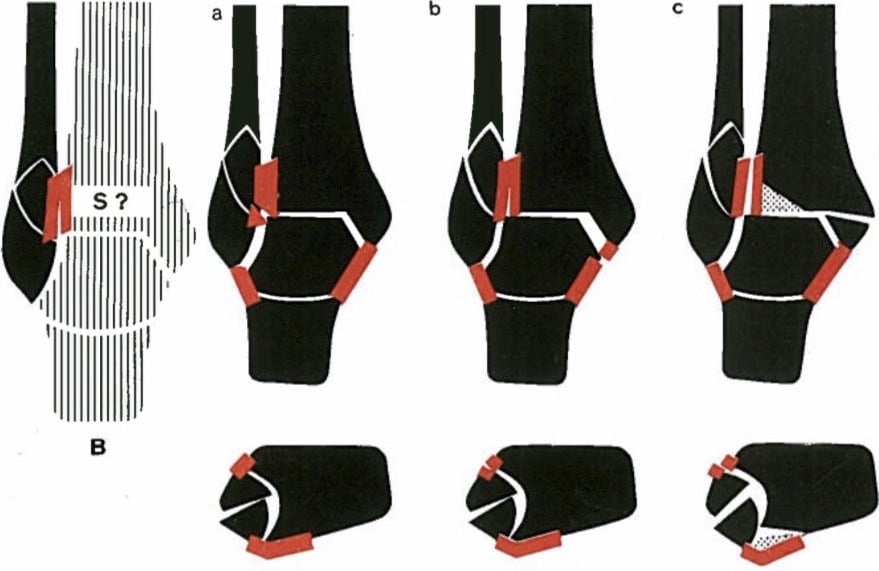Bernhard Weber

Bernhard Georg ‘Hardy‘ Weber (1927-2002) was a Swiss surgeon.
Weber published extensively on many topics, including books on pseudoarthrosis, external fixators, and treatment of fractures in children. Eponymously affiliated with the Danis-Weber ankle fracture classification
Danis-Weber classification system was first described by Robert Danis in 1949 and later modified and popularised by Bernhard Georg Weber in 1972, 10 years after Danis’ death. This simple ankle fracture classification system is more commonly called the Weber ankle fracture classification.
Biography
- Born in Switzerland in 1927
- Medical training at Zürich Balgrist Hospital
- 1959 – Oberarzt (senior surgeon) under Maurice E. Müller at St. Gallen, Switzerland
- 1967 – Chefarzt of Orthopaedics and Trauma at St. Gallen, Switzerland
- Procalimed the “Minimax” slogan (maximum stability with a minimal approach) for minimally invasive hip surgery
- 1986 – Entered private practice
- 2000 – Honorary trustee of the AO Foundation
- Died of heart failure aged 75 in 2002
Medical Eponyms
Danis-Weber ankle fracture classification (Danis 1949; Weber 1972)
The Danis-Weber classification is a method of describing ankle fractures. It has three categories, based primarily upon the fracture of the fibula. The Danis-Weber classification system was first described by Robert Danis in 1949 and later modified and popularised by Weber in 1972, 10 years after Danis’ death.
This simple ankle fracture classification system is more commonly called the Weber ankle fracture classification. It has three categories, based primarily upon the fracture of the fibula.

DANIS (1948) empfiehlt seine rein pathologisch-anatomische Klassifizierung. Danach, in etwas modifizierter Form und anderer Darstellung, unterteilen auch wir die Sprunggelenksverletzungen.
Wir stellen an die Einteilung die Anforderung, daß uns das Röntgenbild auf einen Blick über die pathologisch-anatomische Läsion bis in alle Details orientiert, wobei es uns primär nicht interessiert, wie die betreffende Verletzung zustande gekommen ist. Die Pathologie im Gebiete Fibula – Syndesmose steht dabei im Zentrum des Interesses, und wir kommen zu folgender Klassifizierung der Verletzungen des Oberen Sprunggelenkes:
A. Malleolenbrüche mit Fibulaläsion distal der Syndesmose.
B. Malleolenbrüche mit Fibulaläsion in der höhe der Syndesmose.
C. Malleolenbrüche mit Fibulaläsion proximal der Syndesmose.
Weber BG, 1972: 51 [Original text as PDF]
DANIS (1948) recommends his purely pathological-anatomical classification. Then, in a slightly modified form and a different representation, we also subdivide the ankle injuries.
For the classification we suggest that the X-ray should orientate us to the pathological-anatomical lesion at a single glance, whereby it does not interest us primarily how the respective injury came about. The pathology in the area of the Fibula – syndesmosis is the centre of interest, and we arrive at the following classification of injuries to the upper ankle joint:
A. Malleolar fractures with Fibular lesion distal to the syndesmosis
B. Malleolar fractures with Fibular lesion at the height of the syndesmosis
C. Malleolar fractures with Fibular lesion proximal to the syndesmosis
Weber BG, 1972: 51-63 [Original text as PDF]
Further examples of injuries related to Weber A, B, C injuries discussed by Weber in 1972

The variants of Type A
a. Fibular band rupture
b. Avulsion fracture of the tip of the fibula
c. Transverse fracture at the height of the articulation
d. Additional transverse fracture of the medial malleolus
e. Additional chisel fracture of the medial malleolus
f. Additional fracture of the posterior edge of the tibia, oriented medio-dorsally
Coronal slices: Syndesmosis bands are always intact
Weber BG, 1972: 51-63 [Original text as PDF]

The variants of Type B
a. Isolated oblique fracture of the fibula
b. Additional rupture of the deltoid ligament
c. Additional fracture of the medial malleolus
Coronal slices: Syndesmosis bands either intact or damaged
Weber BG, 1972: 51-63 [Original text as PDF]

The variants of Type C
In all cases higher (and rarely, missing) Fibular fracture
a. Additional rupture of the deltoid ligament
b. Additional fracture of the medial malleolus
c. Additional fracture of the posterior edge of the tibia, oriented latero-dorsally
d. En-bloc sagittal fracture of the tibial tubercle
e. Maisonneuve-style subcapital fracture of the fibula
f. Apparently “clean” burst without fracture of the fibula
Coronal slices: Syndesmosis bands obligately completely insufficient
Weber BG, 1972: 51-63 [Original text as PDF]
Major Publications
- Suessenbach F, Weber BG. Epiphysenfugenverletzungen am distalen Unterschenkel Erfahrungen mit 41 operativ u. 12 konservativ behandelten Fällen. 1970
- Weber BG. Aktuelle Probleme in der Chirurgie. Band 3. Die Verletzungen des oberen Sprunggelenkes [The injuries of the upper ankle] 2e, 1972: 51-63 [Original text as PDF]
- Weber BG, Čech O. Pseudarthrosen: Pathophysiologie, Biomechanik, Therapie, Ergebnisse 1973 [Pseudarthrosis : pathophysiology, biomechanics, therapy, results, 1976]
- Weber BG. Epiphysenfugenverletzungen am distalen Unterschenkel (Epiphysis joint injuries on the distal lower limb) Sondereinband – 1970
- Weber BG, Brunner CF, Freuler F. Die Frakturenbehandlung bei Kindern und Jugendlichen [Treatment of fractures in children and adolescents] 1978
- Brunner CF, Weber BG. Special techniques in internal fixation. 1982
- Weber BG, Magerl F, Brunner CF. The external fixator : AO/ASIF-threaded rod system, spine-fixator. 1985
- Weber BG, Magerl F. Fixateur externe. 1985
References
Biography
- Bernhard Georg Weber, 1927-2002, The Journal of Bone & Joint Surgery. 2003; 85(3): 583
- Amstutz HC. Bernhard Georg Weber (1927-2002), The Journal of Arthroplasty 2004; 19(8): S3: 3-4
- Mostofi SB. Bernhard Georg Weber. in: Who’s Who in Orthopedics. 2005; 355-356
- Bibliography. Weber, B. G. (Bernhard Georg). WorldCat Identities
Eponymous terms
- Bugler KE, White TO, Thordarson DB. Focus on Ankle Fractures. JBJS. 2012. 94:1107-1112
- Cadogan M. Eponymous Foot, ankle and talus injuries. LITFL
- Cadogan M. Danis-Weber classification. Eponym A Day. Instagram
Eponym
the person behind the name
